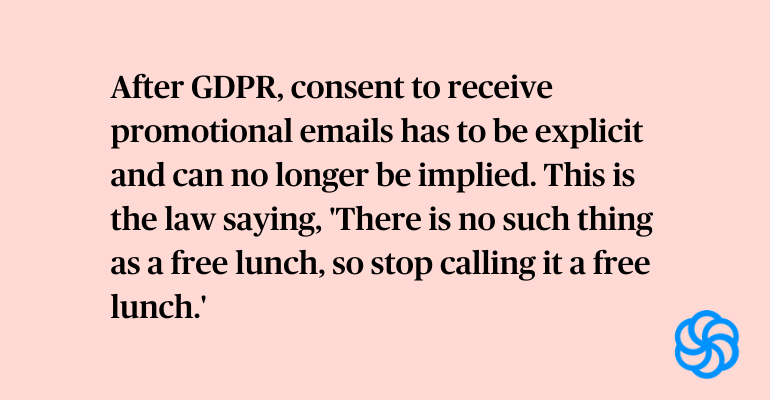
Giveaways have long been hailed as a fast and effective means of gathering new email addresses. But has the GDPR put an end to this practice? The short answer: No, but you’ll have to adapt your approach. This article will tell you how.
Yes, giveaways are still possible under GDPR
“How am I supposed to grow my email list if I can’t run giveaways or freebies anymore since GDPR?”
We’ve heard this concern from a lot of people, but it isn’t exactly true. You CAN still run giveaways to grow your email list.
On 25 May 2018, the General Data Protection Regulation (GDPR) went into effect for companies that do business with residents of the EU. For more on GDPR click here.
Despite it feeling like a distant memory, the GDPR is still a new law. And a lot of misinformation about it is floating around the internet, especially around giveaways.
An important disclaimer: This blog represents our well-researched opinion only. This means it serves informational purposes and does not constitute legal advice.
What is a freebie anyway?
By giveaways and freebies, we mean free resources – including white papers, webinars and e-books – or prize drawings and sweepstakes. Those items marketers pour so much time and money into as enticements for new email subscriptions.
Note, however, that freebie has the word “free” in it. And this is where the problems start. Before the days of GDPR, a well-known tactic for growing your email list was to offer something for free.
This means that marketers promoted “free” ($0) services or products, such as a white paper or sweepstakes entry. In reality, the company’s marketing team was coupling these so-called freebies with the consumer’s implicit consent to receive promotional content. This marketing practice is also called offering “gated content.”
How gated content worked before GDPR
Before, it was like this:
- A potential new email subscriber sees a link to “download a white paper for free.
- This person follows this link and encounters a form where they have to enter their email address. They do this.
- The person becomes a new email subscriber because their data is automatically entered into the company’s database. At the same time, the new email subscriber gets access to the PDF and can download and save this knowledge.
But this freebie wasn’t ever really free to begin with.
Why do companies offer freebies in the first place?
It’s a well-worn saying that there’s no such thing as a free lunch.
And that goes for this kind of freebie, too. The marketing team was retroactively financing their white paper by collecting future leads.
In return, the consumer received access to this white paper, which represents a valuable knowledge resource.
The advantage for consumers was they didn’t have to pay in dollars, pounds or euros, just with their data. Of course, the consumer had the opportunity to withdraw their consent to receive emails at any point.
And the fact that they could retract their consent at any time made “paying with their data” even more attractive for some consumers. After all, they got to keep the knowledge resource they’d received or their sweepstakes entry.
Meanwhile, if a consumer withdrew their consent, the company had to stop marketing to them. Email marketers knew that they had to work hard to hold the attention of these new subscribers.
GDPR changes to giveaways

In Article 7, paragraph 4 of the GDPR, it states that a data subject’s consent must be “freely given” and cannot be forced.
Consent to receive promotional emails has to be explicit and can no longer be implied. Because if you offer a “free service or product” but insist that the user agreed to receive email marketing from you, you are “forcing consent.”
In layman’s terms, the law is saying, “There’s no such thing as a free lunch, so stop calling it a free lunch.”
Putting together a good knowledge resource takes time and effort. And giving away a prize costs money. But don’t worry – you don’t have to start giving everything away “completely free.”
To keep growing your list with giveaways and sweepstakes in a manner that complies with GDPR, you need to use more transparent vocabulary.
Reframing the freebie: How to grow your email list with giveaways
The switch that you need to make is to be clear that the product or service you are offering is not “free of charge.” The consumer is paying in data instead of dollars, pounds or euros.
Of course, you also need to always make sure the consumer knows they have the right to revoke consent at any time.
Follow these two tips and we think you’ll be in good shape:
1) The tie-in has to be presented as an exchange.
Here are some examples we think work well:
- “Your email address is the admission ticket for our webinar.”
- “New subscribers to my monthly email list receive my latest e-book in a welcome email.”
- “Sign up for our newsletter to receive our white paper and further news from us.”
2) Watch your words.
If you are asking for data, don’t use misleading phrases like “free,” “no charge,” or “free of charge.”
Remember, according to the GDPR, these items are NOT free, they cost something – data. Let your potential new leads know that.
Read more about email marketing and what Brevo has done to become GDPR-compliant.
Sweepstakes and prizes: How to use contests to grow your list post-GDPR
Here’s the thing: Doing any sort of contest to boost your email sign-ups has become more difficult since the GDPR was implemented. But it has also become more transparent.
And transparency for the consumer is, ultimately, a good thing.
Think about it this way: It may boost your conversion rate. Consumers won’t feel tricked into email subscriptions they didn’t want.
In our opinion, there are two ways to run a sweepstakes.
1) Make the tie-in transparent
Be clear that the precondition for sweepstakes entry is an email subscription.
Legally, a sweepstakes entry counts as a contract. Make the entry cost an explicit part of the contractual agreement.
2) Uncouple the sweepstakes from the data
A lot of marketers aren’t going to like this option, but hear us out.
Let contestants take part in the sweepstakes without having to consent to receive your emails.
Create an optional opt-in for your newsletter that appears once they’ve entered their data for the prize draw.
Is there an advantage to doing things this way? After all, you’re running the sweepstakes to generate more leads. And, yes, you’ll generate fewer leads if you make the opt-in optional. However, you’ll probably generate higher-quality leads.
What’s more, if this is the first time that people are coming into contact with you, you’ll have the “halo effect” of making a good impression.
You are actually giving something away for free. At your company, there truly is a free lunch.
You’re taking the old marketing adage to heart that “You’ve got to give something to get something.” This will make a good first impression on potential customers, whether they subscribe for your newsletter or not.
Why did the GDPR make it harder to do tie-ins, giveaways and freebies?
In the past, a lot of companies misused “freebies,” contests, tie-ins and, above all, the data they received through these.
Maybe you’ve had the experience yourself of signing up to receive something you thought was free and then receiving unexpected promotional email. It’s not fun, right?
The GDPR addresses the clear lack of transparency around consent to receive promotional emails. This lack of clarity led to a lot of frustrated consumers.
So, now, thanks to the GDPR, there’s transparency for consumers residing in the European Union. Consumers will, in theory, always know what they are consenting to. And if they are paying with data, then a service or product cannot be called “free.”
Even though it’s more work for marketers, in the end, we’ll be more upfront about our plans for using private data. Which will, in turn, lead to happier consumers.
Wrap up
Strike the words “freebie” and “free” from how you present your email marketing giveaways.
Be very clear about what you are offering “in exchange for” a newsletter subscription. Your subscribers will be happier when they know exactly what they are getting themselves into.
So, now you know what’s needed for GDPR compliant giveaways, how about trying Brevo’s marketing software for building email signup forms? Good news – this feature is included in our free plan. All you need to do is open your Brevo account.






